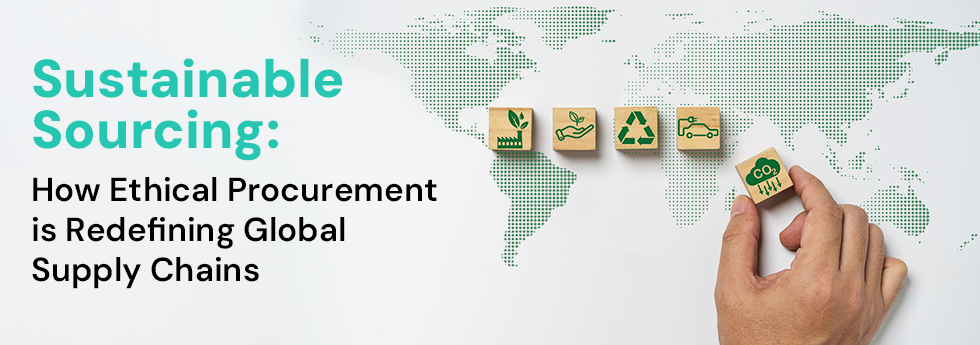In the fast-evolving world of procurement, one trend has emerged as more than just a buzzword: sustainable sourcing. Today, businesses focus not only on costs but also on the environmental and social impact of their supply chains As the spotlight on sustainability grows brighter, ethical procurement has become a key driver of change, transforming global supply chains for the better.
Sustainable sourcing envisions a world where every purchase supports both the planet and people, not just profit. That’s the essence of sustainable sourcing. At its core, it’s the practice of choosing suppliers who not only deliver quality goods at competitive prices but also align with ethical and sustainable business practices. This could mean sourcing materials that are eco-friendly, ensuring fair labor standards, or promoting responsible waste management.
The power of sustainable sourcing goes beyond the immediate transaction. By consciously selecting suppliers that prioritize these values, businesses are actively contributing to a healthier planet, better working conditions, and more resilient communities. In essence, ethical procurement is a tool for creating long-term value—both for businesses and for the world.
Inhaltsverzeichnis
ToggleWhy Should Businesses Care About Ethical Procurement?
While the concept of sustainability might seem idealistic, its benefits are incredibly tangible. Here’s a thought: what if every dollar spent on procurement didn’t just go toward a product but also worked toward a cleaner environment and fairer labor practices? This isn’t a far-off dream—it’s happening right now.
For businesses, adopting sustainable sourcing can yield significant returns. Partnering with ethical suppliers minimizes supply chain risks, enhances brand loyalty, and strengthens consumer trust. Did you know that 83% of consumers say they’re willing to pay more for products from companies that commit to sustainability? The demand is clear, and companies that fail to adapt may find themselves left behind.
This article explores how eProcurement platforms address these risks through key strategies and technologies, helping organizations improve decision-making, anticipate disruptions, and build stronger supply chain relationships.
New Regulations Are Transforming Procurement in Europe
A significant driver of change in the procurement world is the growing wave of regulations across Europe. The Carbon Border Adjustment Mechanism (CBAM) and the Corporate Sustainability Reporting Directive (CSRD) are among the most impactful regulatory frameworks currently in motion.
- CBAM aims to impose a carbon price on imports of certain goods (like cement, steel, and aluminum) into the European Union. The goal is to prevent “carbon leakage” and ensure that companies operating in the EU don’t face unfair competition from industries in countries with weaker environmental regulations. For procurement teams, this means a growing emphasis on sourcing from suppliers with strong carbon management practices, as products that have a higher carbon footprint will face higher tariffs.
- CSRD, on the other hand, mandates that companies report in greater detail on their sustainability practices. Starting in 2024, businesses operating in the EU (or with significant ties to it) will need to disclose comprehensive information on environmental, social, and governance (ESG) criteria. This makes transparency more crucial than ever, as companies will need to prove their ethical and sustainable sourcing practices to stakeholders and regulators alike.
Far from mere bureaucratic hurdles, these regulations are reshaping procurement. Sustainable procurement is no longer optional; it’s a legal mandate. Companies that don’t comply may face financial penalties or find themselves excluded from major markets. Thus, integrating sustainable sourcing and ethical procurement is not just a smart business decision—it’s a strategic necessity.
A Teaching Moment: How Can You Integrate Sustainable Sourcing?
Let’s take a step back and think about how sustainable sourcing can be implemented practically. It’s not just about selecting the “greenest” options—it’s about building a sustainable framework. Begin by auditing your supply chain. Assess each supplier’s environmental impact, labor practices, and sustainability efforts. Are they using renewable energy? Do they have a transparent approach to waste management?
Next, prioritize collaboration. Working with suppliers who are equally committed to sustainability creates a stronger, more resilient supply chain. This could involve partnering with local suppliers to reduce transportation emissions or investing in suppliers who actively innovate to reduce their carbon footprint.
For example, if a supplier’s financial instability is detected alongside delivery delays, companies can take steps to diversify their supplier base or renegotiate contracts. This comprehensive strategy enhances risk mitigation by offering deeper insights into supplier viability.
MeRLIN Sourcing’s Commitment to Sustainable Sourcing
At MeRLIN Sourcing, we believe in the power of ethical procurement to transform businesses and their supply chains. As a leader in strategic sourcing, we help businesses navigate the complexities of sustainable sourcing and ensure that their procurement practices align with their environmental and social goals. With our expertise, we empower companies to reduce their ecological impact while optimizing their supply chains for efficiency and long-term success.
We customers to monitor evolving regulations like CBAM and CSRD, ensuring our clients stay compliant and competitive in Europe. The future of global supply chains is green, and the time to act is now.
The Bottom Line: Sustainability is the Future
As we look toward a future shaped by sustainability and increasing regulation, ethical procurement isn’t just a nice-to-have—it’s a must-have. Businesses that integrate sustainability into their procurement strategies today are leading the charge for a cleaner, fairer, and more profitable tomorrow. The question is: will your business rise to the occasion?



